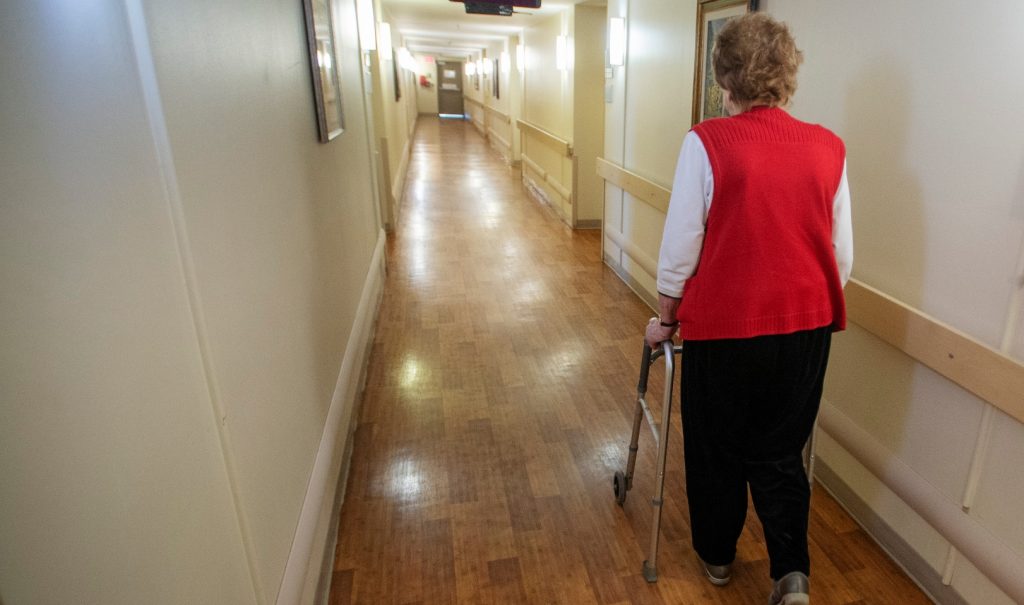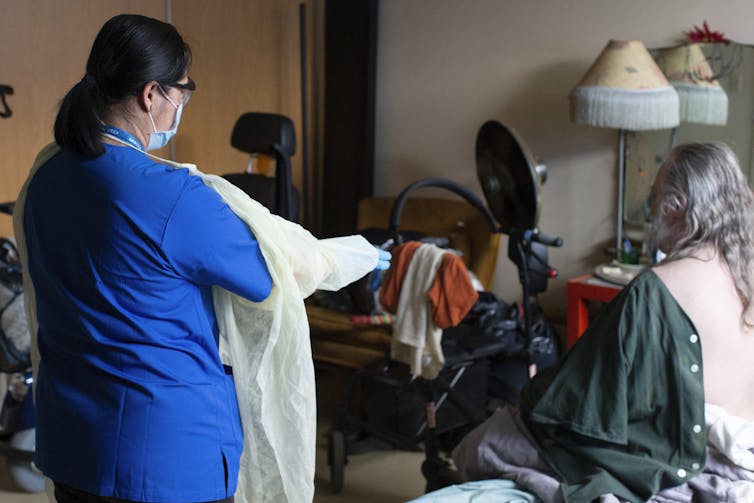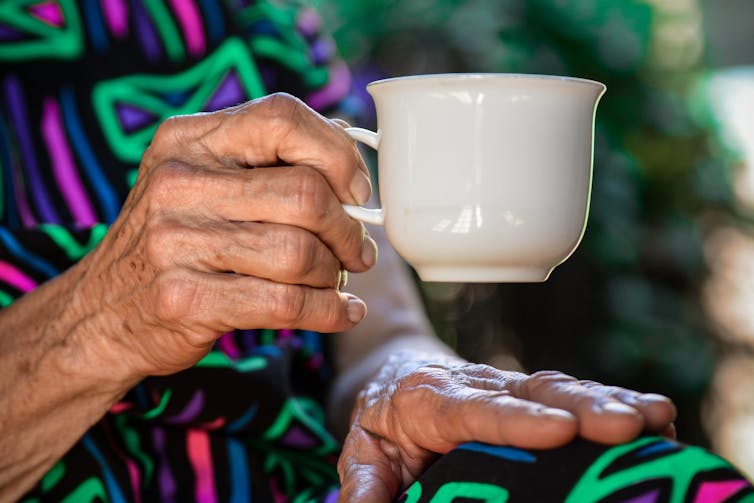After COVID-19’s tragic toll, Canada must improve quality of life in long-term care homes

A resident walks down a hallway at a seniors’ residence in Montréal on Jan. 30, 2020. (Photo by Ryan Remiorz/The Canadian Press)
BY Robert James and Joel Lexchin
June 8, 2020
Robert James is an associate clinical professor emeritus of Family Medicine at McMaster University and Joel Lexchin is a professor emeritus of Health Policy and Management at York University, an emergency physician at University Health Network and an associate professor of Family and Community Medicine at the University of Toronto. This article is republished from The Conversation under a Creative Commons license. Read the original article.
Long-term care homes and nursing homes have become the centre of attention in the midst of the COVID-19 pandemic, with over 80 per cent of deaths from the virus in Canada occurring in these homes.
This tragedy leads us to reflect on what we learned from a decade-long project led by Pat Armstrong, a distinguished research professor at York University, that looked at long-term care in four Canadian provinces (British Columbia, Manitoba, Ontario and Nova Scotia) and five countries (Germany, Sweden, Norway, the United Kingdom and the United States).

Our perspective was not as academics but as doctors: Bob James was a family physician and medical director of a nursing home in Dundas, Ont.; and Joel Lexchin an emergency physician in Toronto who frequently saw patients sent from long-term care homes.
When Bob worked in his nursing home, he was primarily in contact with the registered nurses (RNs), and we suspect this is a common pattern for doctors. When Joel would call to get more information about the patients he was seeing in the emergency room, the people he spoke with were the nurses (usually the RNs). This was largely because of the RNs’ roles in leading the care teams for the homes.
But working in this project taught us many things that changed the way we thought about long-term care homes and the people who live and work in them.
Laundry, support and care
First and foremost, was the importance of the other workers to the care of residents. Specifically, cleaning and laundry staff, as well as kitchen staff, and of course the care aids, or personal support workers (PSWs). We suspected that they played an important role, but over the course of the project it became increasingly clear the importance of those roles in making life for the residents more enjoyable, or even more tolerable.
Laundry and food matters to residents and their families; and the cleaning staff often have long-term and close relationships with the residents. These relationships improve the quality of residents’ lives and their physical health.

That recognition has become even more acute during the crisis in long-term care homes that has followed the COVID-19 pandemic. First, these workers are women — almost 100 per cent of PSWs, plus the majority of laundry, kitchen and cleaning staff, are women. As well, many are immigrants. They are the backbone of the care that residents receive in these homes. When these women are not able to work because they are ill or fear being ill, care collapses — especially when families are not able to step into the breach. Many are also single mothers or are precarious in their employment, so they travel between jobs at two or three homes to earn enough income to survive.
Art and space
Second, incorporating architecture, history and art into the project provided insight into a whole other way of looking at long-term care — one that we had mostly ignored. We realized how much these aspects of homes influence the way that residents interact among themselves and with the staff.
Space matters. How long and wide are the corridors? How is the dining area set up — how many residents to a table? Do people always sit in the same place at every meal? And outside of meals, is there an easily accessible and safe outdoor space for residents to experience the natural world?
What kind of artwork and music does the home have, and does it resonate with the life experience of the residents and provide something to look at other than the ubiquitous television set?
Re-thermalized on a budget of $8.33 per day
We also looked at food and food service in a new way. When Bob was the director of the Dundas home in the late 1990s, the province provided $7 per resident per day for food; by 2017, that had only risen to $8.33 per day. That meant that the kitchen had to accommodate all the special diets (regular, minced, puréed, diabetic, renal and so on) on less money than our federal government gives to prisons to feed their prisoners.

Many homes don’t prepare their own food and don’t use locally available foods. It is trucked in and then reheated — or in the terminology of some homes, re-thermalized. Missing were the smells of food being prepared, smells that are often meaningful to residents. In some homes we visited, the quality of the food was wonderful, but in others it was bland and didn’t carry any appeal beyond just filling people’s stomachs.
Of course, with COVID-19, we have learned that every time a new worker comes into the building to deliver food or services, a new risk is introduced as well.
Future directions
We were struck by the innovation seen in Germany where there was adequate staffing, and co-operative workspaces (here we mean co-operative between the various staff positions, as well as between the staff and the residents). In Germany, one of the staff doubled as a clown, and her non-verbal way of communicating through touch and facial expressions were also lessons for Bob in working with patients with dementia.
The German staff were able and, in fact, encouraged, to do the work that was needed, whether that meant that RNs washed dishes or registered practical nurses combed a resident’s hair. And the residents were encouraged to help with the “chores” of the units, sweeping floors, setting tables, even cutting up the vegetables for the lunch meals! There seemed to be a much more relaxed attitude toward the hierarchy than we see in Canadian homes.

For those of us doctors who are interested in changing the system, and we suspect that there are many, the project and its conclusions has given us a vocabulary to use when working for change.
COVID-19 has taught us how much we in Canada have to do to improve long-term care, as we cope with over-stressed staff in understaffed and aging, underfunded facilities where workers — instead of being seen as essential — are paid at minimal wages and treated as temporary staff.
As they say, this is a marathon rather than a sprint. We were hoping to have some reforms of the system before we need residential care ourselves since both of us are now over 70. We are no longer sure of that, but we still have hope that in the post-COVID-19 world, things might begin to change in the directions we have witnessed elsewhere.![]()
Robert James is an associate clinical professor emeritus of Family Medicine at McMaster University and Joel Lexchin is a professor emeritus of Health Policy and Management at York University, an emergency physician at University Health Network and an associate professor of Family and Community Medicine at the University of Toronto. This article is republished from The Conversation under a Creative Commons license. Read the original article.


